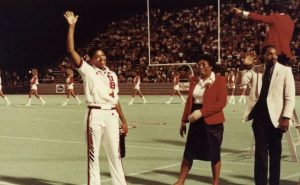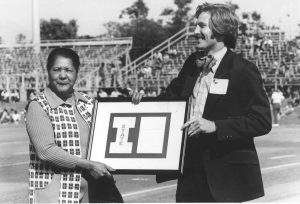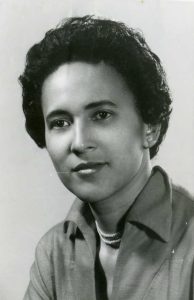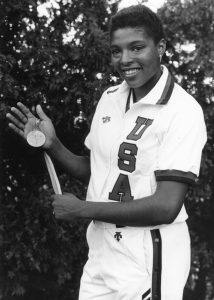Golden contributions: Former Redbirds made Olympic history
By Tom Emery — August 7, 2024
Cathy Boswell (left) is recognized at Hancock Stadium after earning a gold medal at the 1984 Summer Olympics. (Photo courtesy of Illinois State University)
More than a dozen Redbirds have represented Illinois State University at the Olympic games dating back to 1936, from Doug Collins to Charlotte Lewis. Historian Tom Emery profiles two athletes and a coach, who made history at the Olympics.
Tidye Ann Pickett
Tidye Ann Pickett, an Illinois State alumna, was the first African American woman to compete in the Olympics, as she ran in the 80-meter hurdles at the 1936 Games in Berlin.
Pickett fought poverty, racism, and sexism to become one of the nation’s top track stars. Born in Chicago on November 3, 1914, Pickett grew up in the Englewood neighborhood on the city’s South Side. Her family lived across from Washington Park, where the Chicago Daily News sponsored picnics for its delivery boys with foot races and prizes.

Tidye Ann Pickett (left) is presented with a plaque in 1973 commemorating her induction into the Illinois State Athletics Percy Family Hall of Fame. (Photo courtesy of Illinois State University)
In a 1984 interview, Pickett said, “I got into the races and started coming home with baseball hats and cameras.”
She was eventually discovered by John Brooks, a star long jumper at the University of Chicago and future Olympian, who became her coach. “He made sure I had my first pair of good running shoes,” recalled Pickett.
In an era when Olympic sports were dominated by amateur associations, Pickett became a standout with the Chicago-area teams, which were laden with top talent. In January 1932 at age 17, Pickett tied the U.S. indoor record in the 60-yard dash at a meet in the Naval armory in Chicago.
Her determination surpassed her physical size; she stood only 5-foot-2, and barely weighed 100 pounds. As a result, many newspaper accounts called her “little Tidye Pickett.”
Her success in the winter meets lifted Pickett into the 1932 Olympic trials in Chicago that summer, where Pickett and another Black runner, Louise Stokes of Massachusetts, qualified for the 400-meter relay.
However, the women suffered from bigoted actions by the team on the trip to the 1932 Olympics, in Los Angeles. Then, in an obviously racist move, Pickett and Stokes’ spots were given to white athletes. Neither Pickett nor Stokes competed in the games.
Still, Pickett pressed on. As the 1936 Olympic Games in Berlin approached, she added hurdles to her repertoire, and her performances continued to improve.
At a major meet in Toronto in the summer of 1934, Pickett smashed the Canadian record in the broad jump, ran on a relay that set another Canadian record, won the 60-meter dash, and was second in the 80-meter hurdles. In 1935, she was part of a world-record time in the 400-meter relay.
That same year, she enrolled at Illinois State University, declaring a major in health and physical education. Like most schools in an era before Title IX in 1973, Illinois State did not have organized women’s varsity athletics.
However, she received coaching assistance from several individuals, including Joe Cogdal, a mainstay of Illinois State Athletics in multiple sports for decades. The school’s well-developed intramural program was another bonus for Pickett.
In the 1936 nationals at Brown University, Pickett finished second in the 80-meter hurdles to secure her spot on the U.S. Olympic team. She also was expected to run in the 100 and 400.
Pickett was a medal hopeful for the Americans, but she suffered a tragic ending in Berlin. In the second of four qualifying heats on Aug. 5, Pickett came in third, advancing her to the semifinals later that afternoon. In taking the track that day, she became the first African American to compete in the Olympic Games.
However, Pickett hit the second hurdle, sending her crashing to the track. Some newspaper accounts state that the accident left her unconscious. Pickett was eventually diagnosed with a broken foot.
She was quoted by reporters as saying, “I’m heartbroken as I wanted to score another victory for the United States.”
Pickett returned to the United States with a host of souvenirs, which she treasured. She went back to Illinois State that fall and was recognized at Homecoming in October. She also appeared at a meeting of the Women’s Physical Education Club on Nov. 9, “attired in her Olympic costume,” in the words of the Vidette. There, she discussed her experiences at the Olympics.
As a junior at ISU, Pickett was the student head of women’s athletic activities. She was also the secretary of the ISU chapter of Orchesis, described as part of “a national honorary dancing organization for all college girls interested in interpretive dancing.”
Though she was a standout basketball player, Pickett never joined the IM hoops programs at ISU, though she did play field hockey. However, she apparently was unable to finish her education at ISU. In September 1939, the Chicago Defender reported that Pickett was out of money to continue her studies.
She spent several years on barnstorming professional women’s basketball teams, which toured the country. In the 1940s, she earned a degree in education from Pestalozzi Froebel Teachers College, and embarked on a career in the Chicago school system.
Twice married, Pickett raised several children and earned a master’s degree from Northern Illinois University. She spent 23 years as principal of Woodlawn Elementary School on Chicago’s South Side. The school was named in her honor upon her retirement in 1980.
Largely forgotten for decades, Pickett was interviewed by several media outlets and organizing committees for the 1984 Olympics, which returned to Los Angeles. Only then did the racism that she had experienced become known to many.
She died on Nov. 17, 1986. Thirteen years earlier, she was inducted into the Illinois State University Athletics Percy Family Hall of Fame.
Dr. Nell Jackson

Dr. Nell Jackson (Photo courtesy of Illinois State University)
Dr. Nell Jackson, a former Illinois State University faculty member, was the U.S. Olympic women’s track and field coach in both 1956 and 1972.
Born July 1, 1929, Jackson was the first African American to be named head coach of either a men’s or women’s U.S. Olympic track team. At the 1956 Olympics in Melbourne, Australia, her squad included the incomparable Wilma Rudolph, a bronze medalist in the 4×100-meter relay, who went on to win three golds at the next Olympics in 1960.
Later, Jackson became the first Black woman to serve on the board of the U.S. Olympic Committee. In 1989, Jackson was inducted into the U.S. Track and Field Hall of Fame, one of many halls of fame of which she is a member.
Born on July 1, 1929, in Athens, Georgia, Jackson was a four-sport athlete as an eighth grader. But her basketball coach, recognizing her exceptional speed, recommended that she focus on track.
It proved to be good advice, as Jackson ran in the 1944 U.S. national track championships at age 15. The next year, she finished second in the 200 in both the indoor and outdoor Amateur Athletic Union meets. In 1946, she was the 200-meter champion at the first-ever U.S. Junior Nationals for women.
Jackson chose the prestigious Tuskegee Institute for her college career and was a member of the 1948 U.S. Olympic team in London in both the 200 and the 4×100 relay.
In 1949, she set the American record in the 200 with a time of 24.2 seconds. In 1950, Jackson won a pair of collegiate national titles for Tuskegee, capturing the 200 while also running a leg on the 4×100.
At the Pan American Games in Buenos Aires, Argentina, in 1951, Jackson was the silver medalist in the 200, and won a gold with the 4×100. That year, she graduated from Tuskegee, then earned an M.S. from Springfield College in Massachusetts in 1953.
Jackson returned to Tuskegee, where she taught physical education and was the women’s track and field coach from 1953-60. She also began a men’s swimming program at Tuskegee in 1958, serving as its first head coach. Jackson was an assistant coach on the 1960 U.S. Olympic track team.
In 1962, Jackson earned a Ph.D. from the University of Iowa, where she was also on the coaching staff. She then went back to Tuskegee for a year before accepting a faculty position in physical education at Illinois State in 1963.
At Normal, she coached the women’s track team and organized the Bloomington-Normal Track Club, for female athletes ranging from 10 years old to college age. An active campus member, Jackson also delivered various addresses on athletics.
During the summer of 1964, she again was an assistant coach on the U.S. Olympic track team. The next summer, she was also named an assistant on the U.S. women’s team for a tour of West Germany, the USSR, and Poland.
Jackson left Normal after two years, in 1965. She later accepted a faculty position at the University of Illinois, where she led the women’s track team to the 1970 national title.
A prolific writer, she published a host of articles on track and field, as well as athletics on the whole. In 1968, she published Track and Field for Girls and Women, a book which became a standard in the field.
The previous year, she received a grant from the U.S. Olympic Development Committee to produce a 10-minute film to instruct and motivate girls in track and field. By 1970, she was chair of the U.S. Women’s Olympic Track and Field Committee.
In 1973, Jackson was named the first-ever assistant director of athletics for women at Michigan State, a position she held until 1981. She also was the head coach of the women’s track team for six seasons at Michigan State.
Jackson was later the director of physical education at the State University of New York at Binghamton. Following a brief illness, she died on April 1, 1988, at age 58.
Today, Jackson is a member of numerous halls of fame, including in athletics at Michigan State University and the University of Illinois. She is also in the Black Athletes Hall of Fame, the Women’s Sports Foundation Hall of Fame, and the U.S. Track and Field and Cross Country Coaches Association Hall of Fame, among others.
Cathy Boswell

Cathy Boswell holds her Olympic gold medal. (Photo courtesy of Illinois State University)
A contributor to the U.S. women’s basketball team in the 1984 Summer Olympics in Los Angeles was Cathy Boswell ’83, who was just a year removed from an outstanding career at Illinois State.
Boswell’s participation on the 1984 Olympic squad placed her with some of the greatest names in U.S. women’s basketball history as the Americans swept to their first gold medal in the sport. The victory in 1984 also propelled the U.S. women’s basketball program to the international dominance that it still enjoys today.
When she wore the red, white, and blue in Los Angeles, Boswell had racked up plenty of hoops honors in her young life. As a high school freshman, she led Joliet West to the quarterfinals of the first-ever Illinois High School Association girls basketball tournament in 1977. She was back in 1978, tossing in a championship-game record 26 points to lift Joliet West to a 64-48 win over Lincoln for the state title.
Incredibly, Boswell managed to graduate after her junior year of high school and enrolled at Illinois State at the age of 16. The age discrepancy never seemed to bother her, as she set freshman records for points, rebounds, and steals in 1979-80 that still stand.
Boswell a 6-foot guard, was even better as a Redbird sophomore, averaging 18 points per game with six school records for a squad that finished 28-8 and won the 1980-81 Association for Intercollegiate Athletics for Women national title. Though she fractured her ankle midway through her junior year, she still averaged 16.2 points and 7.2 rebounds.
With Boswell on the roster, Illinois State earned bids to the Women’s National Invitational Tournament in both 1980 and 1982, with the program’s first-ever NCAA bid in 1983, the same year the Redbirds won their first-ever conference title.
She finished her career with 2,005 points, one of only two Redbird women’s players to ever reach that mark. Boswell also pulled down 1,054 rebounds while shooting 51.6 percent from the floor. Both remain program records. Illinois State won 90 games in Boswell’s four years on the roster.
In 1984, Boswell entered the Olympic camp as a longshot. But her leadership, work ethic, and determination won out, as was the case throughout her career, and she made the team.
Boswell joined some of the luminaries of women’s basketball history in the country. Among her teammates were Cheryl Miller, a three-time Naismith Player of the Year selection, and Lynette Woodward, who would become the first female player for the Harlem Globetrotters.
Other teammates included Teresa Edwards, who would win the first of four gold medals for USA Basketball in 1984; Anne Donovan, a future title-winning head coach in the WNBA; and Kim Mulkey, the current head women’s basketball coach at LSU. The head coach of the 1984 USA team was Pat Summitt, who won 1,098 games and eight national titles at Tennessee from 1974-2012.
The 1984 Olympics were only the third to feature women’s basketball as a medal sport. Women’s basketball had been introduced in 1976, when Charlotte Lewis ’01, another ISU product, played on the United States team that won the silver.
Boswell played in all six of the Americans’ games at the 1984 Olympics, averaging 12.6 minutes. She enjoyed her best game in an 84-47 rout of South Korea in the group stage on Aug. 2, as she scored 10 points on 4-of-7 shooting to go along with three rebounds, three assists, and two steals.
With such a wealth of talent, the United States tore through the competition, averaging 86 points, while allowing only an average of 53.6. Those blowouts helped the United States become the only team in the field to score more points combined in the tournament than they allowed.
Unlike today, there were few professional opportunities in women’s hoops in Boswell’s era, particularly in the U.S. But she clearly made the most of it.
Boswell eventually played pro basketball for 14 years, mainly in Germany, Italy, Spain, Greece, and Brazil, as well as in the old American Basketball League.
She later spent two years on the women’s basketball coaching staff at Illinois State. Today, Boswell serves as head coach of a high school boys basketball team at an academy for foster children in California.
Boswell is a member of the Illinois State Athletics Percy Hall of Fame, the Missouri Valley Conference Hall of Fame, and the Joliet West High School Hall of Fame. She is the first woman to have her jersey number retired in Illinois State women’s basketball history.
In 2023, she was inducted into the Women’s Basketball Hall of Fame, the latest in a lifetime of hoops highlights for Boswell, one of the greatest to ever wear the red-and-white of Illinois State.
This article is courtesy of Tom Emery and Illinois State University.
Tom Emery is a freelance writer and historical researcher who, in collaboration with Carl Kasten ’66, co-authored the 2020 book “Abraham Lincoln and the Heritage of Illinois State University”. Emery also researches and writes for the “This month in Illinois State University history” series.






